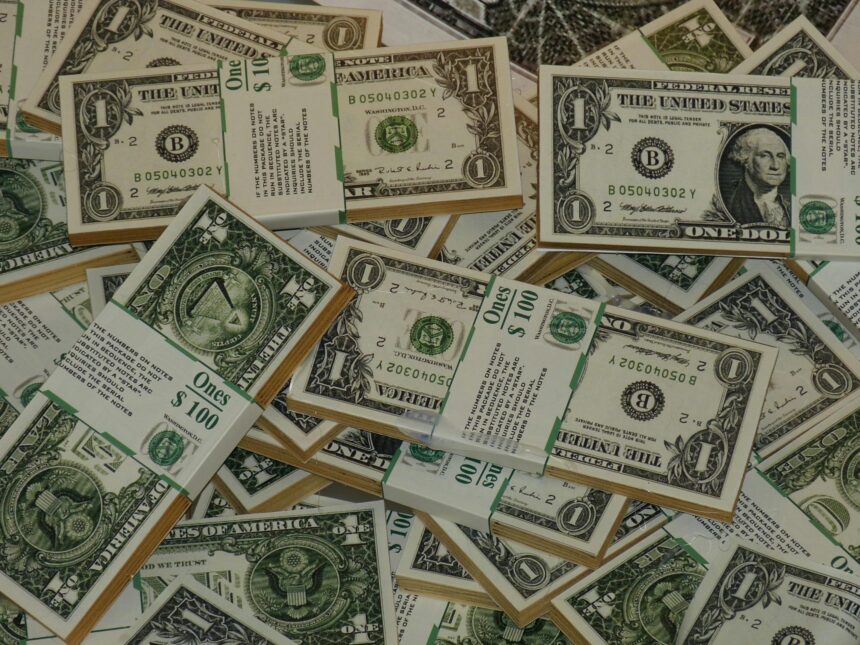The dollar faced challenges in recovering from a five-month low against other major currencies on Wednesday, as traders processed the reciprocal tariffs between the US and EU and the possibility of a ceasefire between Russia and Ukraine, all while anticipating US inflation data amidst economic concerns.
President Donald Trump’s erratic trade policy announcements have caused significant market fluctuations and prompted retaliatory tariffs from trading partners, intensifying a global trade conflict.
The European Commission announced on Wednesday that the European Union would implement counter tariffs on US goods valued at 26 billion euros ($28.39 billion) starting in April, in response to the comprehensive US tariffs on steel and aluminum that took effect earlier that day.
“There are numerous variables at play,” remarked Kenneth Broux, head of corporate research for FX and rates at Societe Generale.
“We are not observing any safe haven in European assets this morning due to the repercussions of the trade war,” Broux further noted.
The euro declined after reaching a five-month high of $1.0947 on Tuesday, following Ukraine’s indication of support for Washington’s proposal for a 30-day ceasefire with Russia. The next move is now up to Moscow.
The Kremlin stated on Wednesday that it was awaiting further details from the US, while senior sources in Moscow indicated that any agreement would need to consider Russia’s territorial gains and address its concerns.
During midday trading in Europe, the euro was down 0.15 percent at $1.0902.
The single currency has been buoyed by the prospect of substantial fiscal spending from Germany, although the situation has become more complicated after the Greens pledged to obstruct those plans and introduced alternative proposals.
This remains the “overarching narrative” for the euro, Broux concluded.
Source of Volatility
The Canadian dollar remained stable following a tumultuous trading session on Tuesday, during which President Trump announced a plan to increase tariffs on steel and aluminum to 50 percent, only to retract that statement a few hours later.
The Bank of Canada is set to make a policy decision later on Wednesday, with market participants anticipating a further quarter-point reduction in interest rates.
The U.S. dollar dipped slightly to C$1.4415.
A Canadian official, who requested anonymity, indicated that Canada would unveil C$29.8 billion in retaliatory tariffs against the United States on Wednesday.
“Trade uncertainty continues to loom, contributing to ongoing market volatility,” stated Kyle Rodda, a senior financial markets analyst at Capital.com.
Rodda further noted that the outlook for U.S. economic growth is worsening, highlighting the significance of the consumer price index (CPI) release later in the day, which he cautioned “could introduce considerable volatility.”
The U.S. dollar index, which gauges the currency’s performance against a selection of six others, increased by 0.1 percent to 103.6, following a decline of 0.46 percent on Tuesday that brought it to its lowest level since October 16.
Investors have been apprehensive since Trump’s interview with Fox News on Sunday, where he refrained from dismissing the potential for a recession stemming from his trade policies. According to Julien Lafargue, chief market strategist at Barclays Private Bank, the upcoming CPI report on Wednesday could create a “lose-lose situation” for the market. He noted that a reading exceeding expectations might reinforce the stagflation narrative, while a lower-than-anticipated figure could heighten recession concerns. “At this juncture, the market requires clearer insights into growth rather than inflation,” Lafargue emphasized.
Additionally, the United States has resumed military assistance and intelligence support to Kyiv. Heightened optimism regarding a resolution to the conflict in Ukraine has strengthened the Swiss franc, which rose to as high as 0.8840 per dollar before retracting some gains. The British pound stabilized at $1.2942, remaining just below the four-month peak of $1.29655 reached in the previous session. The dollar appreciated by 0.6 percent to 148.74 yen, recovering from a five-month low of 146.545 yen recorded earlier.
“We are anticipating Friday’s trade union agreements in Japan,” Broux remarked, describing the dollar’s resilience against the yen, despite tighter bond spreads on Wednesday, as somewhat perplexing. Many of Japan’s largest corporations have met union demands for significant wage increases for the third consecutive year, aiming to assist employees in managing inflation and to retain talent amid labor shortages. However, it remains uncertain whether these wage increases will be sufficient to stimulate consumer spending and prompt the Bank of Japan to adopt a more aggressive stance on its policy rate, which currently stands at a low 0.5 percent.






